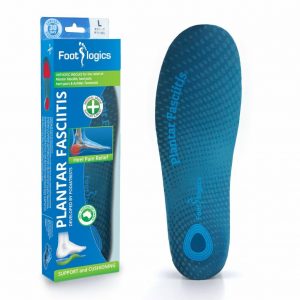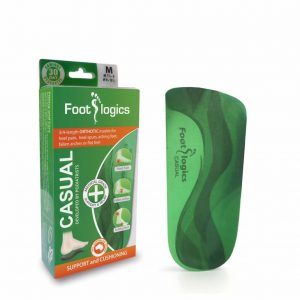Orthotics for Plantar Fasciitis
-
Footlogics Plantar Fasciitis
Orthotic insoles & shoe inserts for Foot Pain $37.95ClearXSSMLXLRated 0 out of 5 -
Footlogics Casual
Orthotic insoles & shoe inserts for Foot Pain $29.95ClearXSSMLXLRated 0 out of 5
Developed by Australian podiatrists, Footlogics orthotic shoe insert are affordable and effective for the relief of Plantar Fasciitis, heel pain or heel spurs. Footlogics is the number 1 selling orthotic in Australia and has been approved by the TGA (Therapeutic Goods Administration) under the ‘Medical Devices’ category, meeting strict health regulations and quality standards.
These orthotics are now available in Canada and come with a 30-Day-Money-Back-Guarantee.
Orthotic insoles Plantar Fasciitis
Orthotics are now suggested by doctors as a way to treat Plantar Fasciitis, heel pain, and heel spurs. Why does that happen? It’s because orthotics work, are simple to use, and don’t cost a lot of money! They naturally ease heel pain by getting our feet to work normally again and keeping the plantar fascia ligament from being overworked.
Plantar Fasciitis
Plantar Fasciitis is the medical term for “inflammation of the plantar fascia” – the connective tissue between the heel and the toes. Because of the constant strain and pressure that is placed on this tissue, which extends from the back of your heel to the front of your foot, you may have discomfort and inflammation in this region over the course of time. As time goes on, the tendon of the plantar fascia becomes abnormally stressed or overworked as a consequence of factors such as excessive activity, weight growth, abnormal foot function, etc. An other factor that contributes to this is wearing shoes that do not fit properly and do not provide enough arch support.
Heel Spurs
A heel spur is a bony, unnatural growth found at the bottom of the heel bone. This condition is often associated with plantar fasciitis. However, it’s a mere symptom of plantar fasciitis and doesn’t cause any pain as such.
Footlogics Orthotics for Plantar Fasciitis
If you suffer from heel pain, an excellent choice would be orthotics from Footlogics. When you stand or walk, these supportive shoe inserts aid by lessening the stress that is placed on your plantar fascia. Footlogics insoles can be used by anyone without requiring a doctor’s prescription. These orthotics are perfect for people who suffer from plantar fasciitis due to their ergonomically contoured design and use of the innovative materials.
Footlogics Orthotics are a medical-grade device composed of medium-density E.V.A. to support the foot in the right places whilst allowing for natural movement. This is in contrast to many other brands of footbeds, insoles, or shoe inserts on the market. Many of which are simply designed to provide cushioning, nothing else.
Because Footlogics are a fully corrective orthotic device, getting used to them can take a little bit of time. Footlogics are comparable to custom-made orthotics, in that they provide biomechanical alignment. However, many offer customers find our insoles more comfortable and less hard compared to custom-made orthotics.
Footlogics orthotics redistribute your body weight evenly across the entire plantar surface of the foot. As a result, shock is absorbed and pressure is relieved from the heels.
Footlogics is used by a wide variety of medical professionals, including podiatrists, physiotherapists and chiropractors. Not only in Australia, but also in other countries such as the US, Germany, Great Britain and South-Korea.
Footlogics orthotics are designed to offer the wearer the utmost level of walking comfort. Each insole offered by Footlogics is developed with the activity in mind that it will be used for, the type of shoe that will be worn, or the foot complaint that will be alleviated by using the orthotics. On this website, you’ll find one of the widest ranges of orthotics available in Canada. Furthermore, we offer a 30-day money-back-guarantee on your purchase!
Pain in the heel area of the foot is called plantar fasciitis, and it is caused by an injury to the connective tissue in that area. The tiny muscles that make up the arch are protected by a tight, inflexible band of connective tissue called the plantar fascia. This construction starts at the tips of the toes and wraps around the front of the heel. If you pull up on your toes, you should feel a band along the inside of your foot’s arch.
Plantar fasciitis discomfort is localised to the heel.
The usual function of the plantar fascia is to assist in maintaining the arch while standing and walking. Fascia tightens and the arch becomes rigid when the toes extend at the end of a step when weight is on the ball of the foot. By doing so, you may use the powerful muscles in your calf’s back to exert force into your foot without worrying about your arch giving way. Many plantar fascia fibres wrap around the back of the heel to join the Achilles tendon there.
An injury that occurs directly to the heel can also be caused by a quick or severe hit, such as the kind that can occur after a fall from a height; however, this type of injury is much less common than injuries that occur as a result of repetitive usage. The condition will become even worse if there is anything that either increases the amount of strain that is placed on the plantar fascia or the duration of time that the plantar fascia is tensed. This comprises posture, both of the body and the foot, as well as the shoe wear, occupation, and recreational activities that one participates in. Overuse of the forefoot may play a significant part in the development of this ailment.
Sadly, the condition of this structure worsens as time passes and more people use it. While we are older, a usage that we were able to endure when we were younger may cause us discomfort and irritate our skin. It is more common for plantar fasciitis to progress to an irreparable stage, which may necessitate surgical intervention. On the other hand, the only method to establish whether or not plantar fasciitis can be treated without the need for surgery is to treat it as aggressively and effectively as possible.
It is necessary to take into consideration other possible diagnosis. Plantar fasciitis affects only the bottom of the heel, which is the part of the foot that bears the most weight. It is frequently located on the portion of the heel pad that is internal and forwards (towards the toes). On occasion, other regions of the plantar fascia, such as the exterior of the heel pad or the arch, may also be painful.



